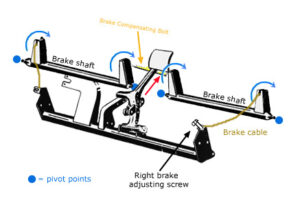KR200 Brake Maintenance
- Home
- KR200 Brake Maintenance
-
By: admin
- 0 Comments
 The KR-200 manual has a procedure for adjusting brakes that is somewhat deceiving. It states that the right brake adjusting screw will adjust the right brake and the left adjusting screw for the left brake. This may appear to be the case but it is not really true. If you look at the exploded view of the braking system you can see the brake pedal which is attached at the bottom and is free to rotate. Higher up on the brake pedal is what they call a ‘brake compensating bolt’. It’s not a bolt but is actually a rod. The brake pedal pushes on the center of the rod, as shown by the red arrow, and the rod is able to tilt. The ends of the rods are connected to the inside arms of the brake shafts. The outside arms of the brake shafts pull on the brake cables.
The KR-200 manual has a procedure for adjusting brakes that is somewhat deceiving. It states that the right brake adjusting screw will adjust the right brake and the left adjusting screw for the left brake. This may appear to be the case but it is not really true. If you look at the exploded view of the braking system you can see the brake pedal which is attached at the bottom and is free to rotate. Higher up on the brake pedal is what they call a ‘brake compensating bolt’. It’s not a bolt but is actually a rod. The brake pedal pushes on the center of the rod, as shown by the red arrow, and the rod is able to tilt. The ends of the rods are connected to the inside arms of the brake shafts. The outside arms of the brake shafts pull on the brake cables.
Now assume that the right brake adjustment is too tight. When the brakes are applied, the right cable will pull the brake shoe against the drum and apply some pressure. The ‘Compensating rod’ will tilt to rotate the left brake shaft and try to get equal pressure on the left brake shoe and drum. If you have trouble getting good brake adjustment, it may be in the brake cables but look at the pivot points of the brake shafts. I have found on my 48 yr. old Messerschmitt that the pivot points were rusted and one of the brake shafts was binding. After lubricating and getting everything to move freely, I now have good brakes.
The rear brake should be adjusted to operate after the front brakes are applied. With slight brakes being applied to the front, the rear wheel should turn freely and be almost starting to brake.
Prev Post
Converting your KR200..
Next Post
Messerschmitt Owners’ Club..
Related Post
- April 4, 2018
Tri-Tech Replica KR200 Brochure 1997
- March 7, 2018
